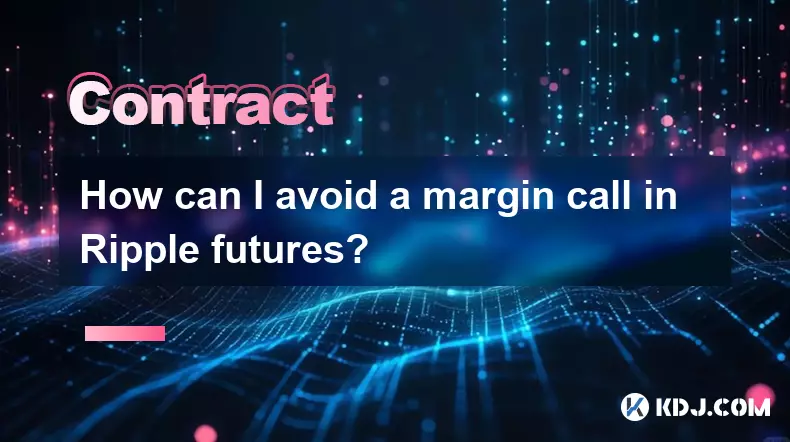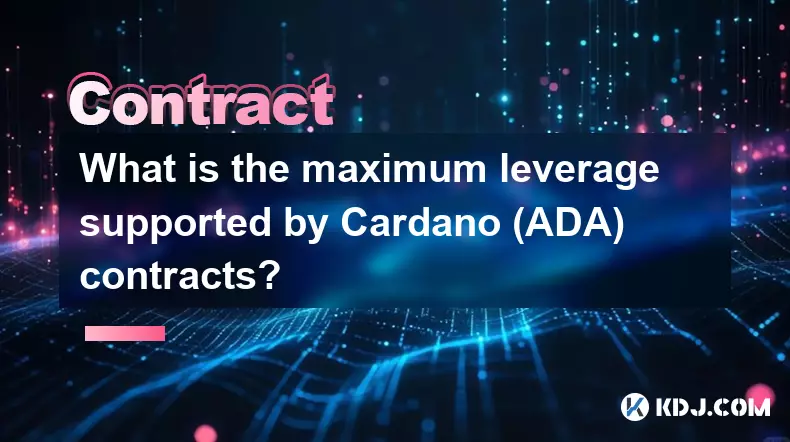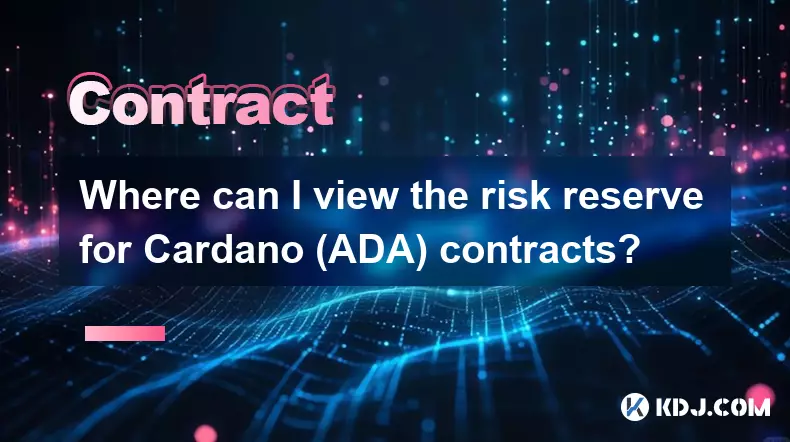-
 bitcoin
bitcoin $112195.049338 USD
2.42% -
 ethereum
ethereum $4124.915858 USD
2.81% -
 tether
tether $1.000570 USD
0.02% -
 xrp
xrp $2.861568 USD
2.25% -
 bnb
bnb $1000.346670 USD
3.04% -
 solana
solana $209.070819 USD
3.38% -
 usd-coin
usd-coin $0.999870 USD
0.02% -
 dogecoin
dogecoin $0.235379 USD
2.65% -
 tron
tron $0.335681 USD
-0.20% -
 cardano
cardano $0.803501 USD
3.38% -
 hyperliquid
hyperliquid $47.120881 USD
3.56% -
 chainlink
chainlink $21.501300 USD
3.44% -
 ethena-usde
ethena-usde $1.000571 USD
0.02% -
 avalanche
avalanche $29.793378 USD
3.62% -
 stellar
stellar $0.366964 USD
2.42%
How can I avoid a margin call in Ripple futures?
Understanding margin requirements in XRP futures is crucial—maintain adequate capital, monitor real-time ratios, and stay updated on exchange policies to avoid unexpected liquidations.
Sep 29, 2025 at 01:36 pm

Understanding Margin Requirements in Ripple Futures
1. Each futures contract on Ripple (XRP) comes with specific margin requirements set by the exchange. These requirements determine how much capital you must maintain in your account to keep your position open. Falling below this threshold triggers a margin call, which forces either additional funding or liquidation of your position.
2. Initial margin is the amount required to open a position, while maintenance margin is the minimum balance needed to keep it active. Traders often overlook the difference, leading to unexpected calls when market movements reduce equity below maintenance levels.
3. Exchanges frequently update margin rules based on volatility and regulatory developments. Staying informed about policy changes from platforms like BitMEX, OKX, or Bybit ensures you’re not caught off guard by sudden increases in required collateral.
Monitoring real-time margin ratios through trading dashboards helps detect risk before it escalates into a full margin call.Implementing Effective Risk Management Strategies
1. Position sizing plays a critical role in avoiding excessive leverage. Limiting each trade to a small percentage of total account value—typically between 1% and 5%—reduces exposure and buffers against sharp price swings in XRP futures.
2. Utilizing stop-loss orders tailored to technical support and resistance levels automatically closes positions before losses deplete margin reserves. These tools act as safeguards during high-volatility events such as regulatory announcements or macroeconomic shifts affecting crypto markets.
3. Avoiding over-leverage is essential. While some exchanges offer up to 100x leverage on XRP pairs, using even half that multiplier can rapidly erode equity with minor adverse moves. Conservative leverage settings improve sustainability across multiple trades.
Diversifying across different settlement types—such as quarterly versus perpetual contracts—can spread risk and reduce dependency on single margin pools.Leveraging Real-Time Monitoring Tools
1. Most derivative exchanges provide margin calculators and liquidation price indicators within their trading interfaces. Actively referencing these tools allows traders to adjust positions proactively rather than reactively.
2. Setting up price alerts via API integrations or mobile notifications enables immediate response to market shifts. For example, if XRP drops 7% in a short window, being notified instantly lets you add funds or close part of the position before hitting the maintenance threshold.
3. Some advanced platforms offer stress-test simulations showing potential loss under various volatility scenarios. Running these tests before entering large positions reveals hidden vulnerabilities in your margin buffer.
4. Third-party portfolio trackers like CoinGecko Portfolio or Delta sync with exchange APIs to aggregate margin usage across multiple accounts, giving a holistic view of overall risk exposure.
Frequently Asked Questions
What happens when a Ripple futures margin call is triggered?When your equity falls below the maintenance margin, the exchange issues a margin call. You must deposit more funds or close part of your position. If no action is taken, the platform will forcibly liquidate your contract at prevailing market rates, often resulting in significant losses.
Can I use XRP tokens as collateral for XRP futures?Yes, several exchanges allow native XRP holdings to serve as collateral. However, the valuation may be discounted due to volatility, and not all platforms accept the same assets for margin purposes. Always verify eligible collateral types before initiating leveraged trades.
How does funding rate affect margin in perpetual XRP futures?Perpetual contracts charge periodic funding fees based on the premium between spot and futures prices. Long position holders often pay shorts when demand is high. These recurring payments gradually reduce available margin over time, increasing the likelihood of a call if unaccounted for.
Are there differences in margin rules between U.S.-based and offshore exchanges?Absolutely. Regulated U.S. derivatives platforms like CME enforce stricter margin protocols with lower leverage options. Offshore exchanges typically permit higher leverage but carry greater counterparty risk. The margin thresholds, audit standards, and liquidation procedures vary significantly between jurisdictions.
Disclaimer:info@kdj.com
The information provided is not trading advice. kdj.com does not assume any responsibility for any investments made based on the information provided in this article. Cryptocurrencies are highly volatile and it is highly recommended that you invest with caution after thorough research!
If you believe that the content used on this website infringes your copyright, please contact us immediately (info@kdj.com) and we will delete it promptly.
- Solana at $197: Hunting for High-ROI Tokens in the Crypto Jungle
- 2025-09-30 03:05:17
- Mike Novogratz's XRP U-Turn: From Underestimated to Undeniable
- 2025-09-30 03:05:17
- SANDchain, Token Launchpads, and the Sandbox: Riding the Web3 Wave
- 2025-09-30 03:18:35
- Axl Rose's Graphic Novel: Can He Save Humanity From Paradise City?
- 2025-09-30 02:45:11
- Predictive Oncology's Bold Leap: AI, Digital Assets, and a Treasury Strategy Revolution
- 2025-09-30 03:18:35
- Axl Rose's 'Appetite for Destruction' Gets a Graphic Novel Makeover!
- 2025-09-30 02:45:11
Related knowledge

What is the maximum leverage supported by Cardano (ADA) contracts?
Sep 30,2025 at 03:37am
Understanding Leverage in ADA Derivatives Trading1. Leverage in cryptocurrency futures and perpetual contracts allows traders to control larger positi...

How do I use the scheduled order feature in Cardano (ADA) contracts?
Sep 28,2025 at 10:18pm
Understanding Scheduled Orders in Cardano Smart ContractsCardano operates on a proof-of-stakes consensus mechanism and uses the Plutus scripting langu...

Where can I view the risk reserve for Cardano (ADA) contracts?
Sep 29,2025 at 09:19pm
Risk Reserve Overview in Cardano (ADA) Ecosystem1. The concept of a risk reserve within the Cardano blockchain does not align with traditional central...

How do I enable the "scalping-only" mode for Cardano (ADA) contracts?
Sep 24,2025 at 03:19am
Understanding Scalping Strategies in Crypto Derivatives1. Scalping in cryptocurrency trading refers to executing multiple short-term trades within min...

What is the settlement time for Cardano (ADA) contracts?
Sep 28,2025 at 04:18am
Understanding Cardano's Contract Settlement Mechanism1. Cardano operates on a proof-of-stake consensus model known as Ouroboros, which fundamentally i...

How do I add margin to Cardano (ADA) contracts?
Sep 27,2025 at 07:54pm
Understanding Margin in Cardano (ADA) Smart ContractsCardano operates on a proof-of-stake blockchain that supports smart contracts through its Plutus ...

What is the maximum leverage supported by Cardano (ADA) contracts?
Sep 30,2025 at 03:37am
Understanding Leverage in ADA Derivatives Trading1. Leverage in cryptocurrency futures and perpetual contracts allows traders to control larger positi...

How do I use the scheduled order feature in Cardano (ADA) contracts?
Sep 28,2025 at 10:18pm
Understanding Scheduled Orders in Cardano Smart ContractsCardano operates on a proof-of-stakes consensus mechanism and uses the Plutus scripting langu...

Where can I view the risk reserve for Cardano (ADA) contracts?
Sep 29,2025 at 09:19pm
Risk Reserve Overview in Cardano (ADA) Ecosystem1. The concept of a risk reserve within the Cardano blockchain does not align with traditional central...

How do I enable the "scalping-only" mode for Cardano (ADA) contracts?
Sep 24,2025 at 03:19am
Understanding Scalping Strategies in Crypto Derivatives1. Scalping in cryptocurrency trading refers to executing multiple short-term trades within min...

What is the settlement time for Cardano (ADA) contracts?
Sep 28,2025 at 04:18am
Understanding Cardano's Contract Settlement Mechanism1. Cardano operates on a proof-of-stake consensus model known as Ouroboros, which fundamentally i...

How do I add margin to Cardano (ADA) contracts?
Sep 27,2025 at 07:54pm
Understanding Margin in Cardano (ADA) Smart ContractsCardano operates on a proof-of-stake blockchain that supports smart contracts through its Plutus ...
See all articles


























![[Pycoin] PI Coin -Shocking Listance of Pycoin?! 'Rebellion' This time ... Pay attention to #paikoin [Pycoin] PI Coin -Shocking Listance of Pycoin?! 'Rebellion' This time ... Pay attention to #paikoin](/uploads/2025/09/29/cryptocurrencies-news/videos/pycoin-pi-coin-shocking-listance-pycoin-rebellion-time-pay-attention-paikoin/68da82f23cec1_image_500_375.webp)















































